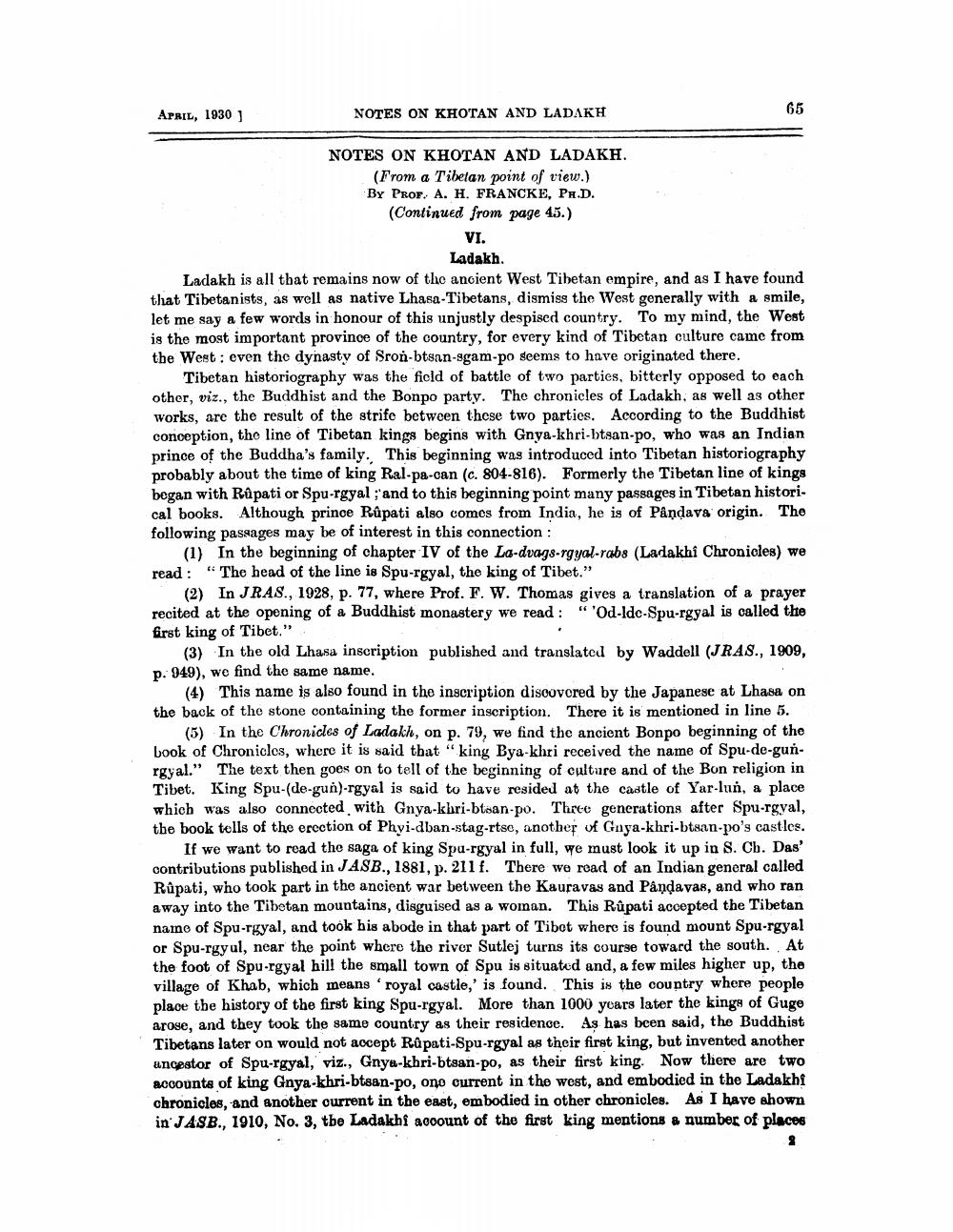________________
APRIL, 1930
NOTES ON KHOTAN AND LADAKH
NOTES ON KHOTAN AND LADAKH.
(From a Tibetan point of view.) BY PROF. A. H. FRANCKE, Ph.D. (Continued from page 45.)
VI.
Ladakh. Ladakh is all that remains now of the ancient West Tibetan empire, and as I have found that Tibetanists, as well as native Lhasa-Tibetans, dismiss the West generally with a smile, let me say a few words in honour of this unjustly despised country. To my mind, the West is the most important province of the country, for every kind of Tibetan culture came from the West: even the dynasty of Sron-btsan-sgam-po seems to have originated there.
Tibetan historiography was the field of battle of two parties, bitterly opposed to each other, viz., the Buddhist and the Bonpo party. The chronicles of Ladakh, as well as other works, are the result of the strife between these two parties. According to the Buddhist conception, the line of Tibetan kings begins with Gnya-khri-htsan-po, who was an Indian prince of the Buddha's family. This beginning was introduced into Tibetan historiography probably about the time of king Ral-pa-can (c. 804-816). Formerly the Tibetan line of kings began with Râpati or Spu-rgyal ;'and to this beginning point many passages in Tibetan histori. cal books. Although prince Rûpati also comes from India, he is of Pândava origin. The following passages may be of interest in this connection:
(1) In the beginning of chapter IV of the La-dvags-rgyal-rabs (Ladakhi Chronicles) we read: "The head of the line is Spu-rgyal, the king of Tibet.”
(2) In JRAS., 1928, p. 77, where Prof. F. W. Thomas gives a translation of a prayer recited at the opening of a Buddhist monastery we read: "'Od-Ido-Spu-rgyal is called the first king of Tibet."
(3) In the old Lhasa inscription published and translated by Waddell (JRAS., 1909, p. 949), we find the same name.
(4) This name is also found in the inscription discovered by the Japanese at Lhasa on the back of the stone containing the former inscription. There it is mentioned in line 5.
(5) In the Chronicles of Ladakh, on p. 79, we find the ancient Bonpo beginning of the book of Chronicles, where it is said that "king Bya-khri received the name of Spu-de-gunrgyal." The text then goes on to tell of the beginning of culture and of the Bon religion in Tibet. King Spu-(de-gun)-rgyal is said to have resided at the castle of Yar-lun, a place which was also connected with Gnya-khri-btsan-po. Thrte generations after Spu-rgyal, the book tells of the erection of Phyi-dban-stag-rtso, another of Guya-khri-btaan-po's castles.
If we want to read the saga of king Spu-rgyal in full, we must look it up in S. Ch. Das' contributions published in JASB., 1881, p. 211 f. There we read of an Indian general called Rûpati, who took part in the ancient war between the Kauravas and Pandavas, and who ran away into the Tibetan mountains, disguised as a woman. This Rupati accepted the Tibetan name of Spu-rgyal, and took his abode in that part of Tibet where is found mount Spu-rgyal or Spu-rgyul, near the point where the river Sutlej turns its course toward the south. At the foot of Spu-rgyal hill the small town of Spu is situated and, a few miles higher up, the village of Khab, which means 'royal castle,' is found. This is the country where people place the history of the first king Spu-rgyal. More than 1000 years later the kings of Guge arose, and they took the same country as their residence. As has been said, the Buddhist Tibetans later on would not accept Rupati-Spu-rgyal as their first king, but invented another unqpstor of Spu-rgyal, viz., Gnyu-khri-btsan-po, as their first king. Now there are two accounts of king Gnya-khri-btsan-po, ono current in the wost, and embodied in the Ladakhi chronicles, and another current in the east, embodied in other chronicles. As I have shown in JASB., 1910, No. 3, the Ladakhi account of the first king mentions a number of places




